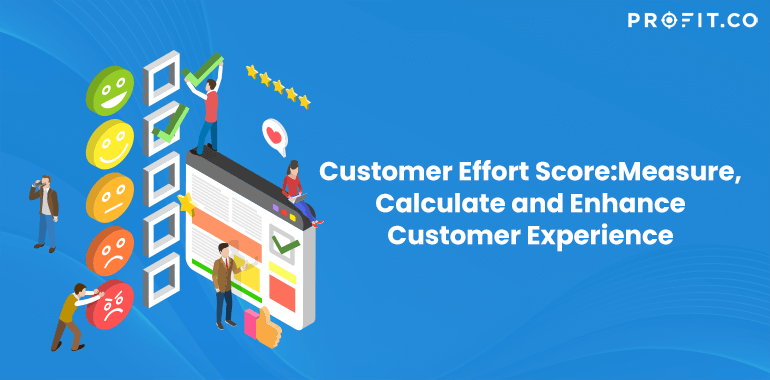Introduction
Delivering exceptional customer experiences can help you attain paramount success. One effective metric that helps organizations gauge the ease of doing business with customers is the Customer Effort Score (CES). By assessing CES, companies gain a deeper understanding of their customers’ needs and expectations. They can identify areas of improvement and implement strategic changes to reduce customer effort and enhance satisfaction. Whether it’s simplifying the purchasing process, improving self-service options, or optimizing customer support channels, CES serves as a compass guiding organizations towards customer-centric enhancements. Let’s see what this blog has to say about using Customer effort score KPI.
What is the Customer Effort Score (CES)?
Customer Effort Score (CES) is a metric that measures the level of effort customers have to exert to interact with a company or resolve a specific issue. It focuses on assessing the ease of the customer journey, aiming to minimize customer effort and enhance overall satisfaction.
I have been struck again and again by how important measurement is to improving the human condition.
How to Calculate Customer Effort Score?
CES is typically measured through a post-interaction survey, asking customers to rate their experience on a scale ranging from “Very Easy” to “Very Difficult.” The calculation involves averaging the individual scores to determine the overall CES.
Formula

Calculation
Sum of Individual Customer Effort Rating: 235
Total Number of Respondents: 50
To calculate CES, you would divide the sum of individual customer effort ratings by the total number of respondents:
CES = Sum of Individual Customer Effort Rating / Total Number of Respondents
CES = 235 / 50
CES = 4.7
Therefore, the Customer Effort Score (CES) based on the given data is 4.7.
Start tracking your KPIs and make data-driven decisions!
Real-World Examples of CES Implementation
- A telecommunications company wants to assess the customer’s effort in setting up a new internet connection. They survey customers after the installation, asking them to rate the experience. Based on the responses, they calculate the CES and identify areas for improvement, such as simplifying the installation steps or enhancing customer support during the process.
- An e-commerce platform measures customer effort during the returns and refund process. After each return, they gather insights on how effortless or cumbersome the experience was by conducting a CES survey. The company can then analyze the data, identify pain points, and implement changes to streamline the returns process, reducing customer effort and increasing satisfaction.
Benefits of Customer Effort Score
Identifying customer pain points
CES helps pinpoint specific areas where customers face challenges or encounter high levels of effort.
Predicting customer loyalty
Research has shown that reducing customer effort leads to higher customer loyalty and helps gauge the impact on customer retention rate and advocacy.
Driving process optimization
CES is a powerful tool for identifying bottlenecks, inefficiencies, and complex organizational processes.
This insight allows businesses to streamline operations, simplify workflows, create seamless customer interactions, and deliver amazing customer support.
Align OKRs with CES
Objective: Improve Customer Experience
Key Result 1: Achieve a CES of 4.5 or higher by the end of the quarter
Initiatives: Implement customer feedback system, optimize customer support processes
Key Result 2: Receive no more than 50 customer complaints related to effort issues
Initiatives: Conduct root cause analysis of complaints, address pain points, streamline customer interactions
Key Result 3: Attain a CES score of 4.8 or higher
Initiatives: Monitor industry benchmarks, implement customer-centric initiatives
Setting these OKRs establishes measurable objectives and key results to improve the Customer Effort Score. This allows you to track progress, focus efforts on addressing customer pain points, and drive improvements in the overall customer experience.
The customer effort score and other customer success metrics can all be easily tracked and improved by using OKRs. Profit.co has a set of customer experience OKR examples for organizations to use as a guide to drive their customer success strategies through OKRs.
FAQs
1. How often should CES surveys be conducted?
The frequency of conducting Customer Effort Score (CES) surveys rests on a few common approaches.
- Post-Interaction CES
Conducting CES surveys immediately after specific customer interactions, such as completing a purchase, receiving customer support, or using a particular service.
- Periodic CES
Implementing CES surveys regularly, such as monthly, quarterly, or annually, to capture the overall customer experience across different touchpoints.
- Trigger-Based CES
Sending CES surveys triggered by specific events, such as when a customer cancels a subscription, submits a complaint, or completes a significant milestone with your product or service.
Consider the nature of your business, customer lifecycle, and the desired level of granularity in feedback to determine the optimal frequency for your CES surveys.
2. Is CES applicable to all industries?
CES is a valuable customer experience metric in any industry.
3. Can CES be combined with other customer experience metrics?
By integrating CES with metrics like Net Promoter Score (NPS), Customer Satisfaction Score (CSAT), or Customer Loyalty Index (CLI), you can gain a comprehensive understanding of different dimensions of the customer experience. This combination allows you to assess the overall satisfaction, likelihood to recommend, and ease of doing business.
Conclusion
Measuring and optimizing the Customer Effort Score (CES) is vital to building exceptional customer experiences. By implementing CES surveys, calculating the score, and taking necessary actions, organizations can identify pain points, enhance customer satisfaction, and drive customer loyalty. Remember, the key lies in minimizing customer effort at every touchpoint and establishing a solid foundation for long-term success in today’s customer-centric landscape.

